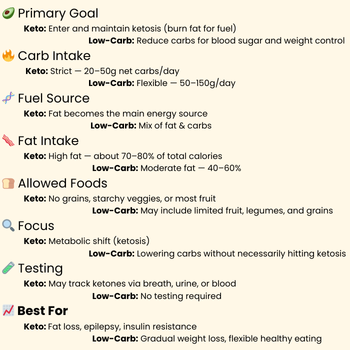
In the ever-evolving world of nutrition, two diets have captured the attention of health enthusiasts and those seeking weight loss solutions: the Keto and Low Carb diets.
With both offering promising results, understanding the differences, benefits, and potential impacts of each approach is vital for making an informed choice.
In this post, we will dig into the principles of each diet, compare their macronutrient ratios, examine their health impacts, and help you determine which one best suits your lifestyle and weight loss goals.
Download your FREE Macros Tracker Sheet here

TL;DR
- The keto diet emphasizes high fat intake and low carbohydrate consumption to induce ketosis.
- Low carb diets allow for a broader range of food options while still focusing on reducing carbs.
- Macronutrient ratios differ significantly between keto and low carb diets, affecting energy use.
- Both diets can contribute to weight loss but may have varying impacts on overall health.
- Selecting the right diet depends on individual lifestyle, preferences, and health goals.
Understanding the Keto Diet: Principles and Benefits
The keto diet, short for ketogenic diet, and the low carb diet are often pitted against each other in discussions about effective weight loss strategies.
At its core, the keto diet is a high-fat, very low-carbohydrate diet designed to shift the body into a state of ketosis, where fat is burned for fuel instead of carbohydrates.
This results in rapid weight loss and numerous health benefits, such as improved mental clarity and energy levels.
In contrast, a low carb diet generally allows for a slightly higher carb intake, making it less restrictive and easier to maintain for some individuals.
However, while both dietary approaches can lead to weight loss, the keto diet’s more stringent carb limits might be more effective for those seeking significant fat loss in a shorter period.
Understanding the principles and benefits of these diets can help you choose the best path for your health goals.
Exploring the Low Carb Diet: Key Characteristics and Advantages
When it comes to weight loss and health improvement, understanding the nuances between the keto vs low carb diet is essential.
Both dietary approaches focus on reducing carbohydrate intake but differ significantly in their macronutrient distributions.
A low carb diet generally allows for higher amounts of protein and healthy fats, while the ketogenic diet emphasizes a drastic reduction in carbs, typically to under 50 grams per day, prompting the body to enter ketosis—a metabolic state where fat becomes the primary energy source.
One of the key characteristics of a low carb diet is its flexibility; individuals can experience weight loss and improved energy levels without strictly adhering to the rigid rules of keto.
Additionally, both diets have been shown to offer advantages such as improved blood sugar control, reduced hunger levels, and enhanced mental clarity.
By exploring the keto vs low carb diet, individuals can determine which plan aligns with their personal health goals and lifestyle preferences.
‘The greatest wealth is health.’ – Virgil

Download your FREE Macros Tracker Sheet here
Comparing Macronutrient Ratios: Keto vs Low Carb
When delving into the world of weight loss and health, the keto vs low carb diet debate is a hot topic among fitness enthusiasts and health-conscious individuals alike.
Both diets emphasize reduced carbohydrate intake, but they differ significantly in their macronutrient ratios.
The ketogenic diet typically consists of a very low carbohydrate intake, usually around 5-10% of total daily calories, which pushes the body into a state of ketosis where it burns fat for fuel.
In contrast, a low carb diet generally allows for a higher carbohydrate percentage, ranging from 10-30%, making it more flexible and easier for many to maintain in the long run.
While the keto diet provides rapid weight loss and easy satiety, the low carb diet may suit those seeking moderate, sustainable changes.
Understanding the nuances of these macronutrient distributions can help you make an informed choice that aligns with your health goals and lifestyle.
Potential Health Impacts: Weight Loss and Beyond
When comparing the keto vs low carb diet, it’s essential to understand not only the primary differences but also the potential health impacts each approach may have on weight loss and overall well-being.
The ketogenic diet, which significantly reduces carbohydrate intake while promoting high fat consumption, often leads to rapid weight loss as the body shifts into ketosis, utilizing fat for energy.
On the other hand, a low carb diet allows for more flexibility in carbohydrate intake and can also result in weight loss, albeit typically at a slower pace compared to the keto diet.
However, both diets may improve metabolic health by enhancing insulin sensitivity and reducing blood sugar levels.
Beyond weight loss, followers of these diets often report increased energy levels and reduced hunger cravings, making them effective long-term strategies for weight management.
Yet, it’s crucial to approach these diets thoughtfully, ensuring they are balanced with nutrient-rich foods to prevent potential nutrient deficiencies.

Choosing the Right Diet for Your Lifestyle and Goals
When it comes to selecting the right eating plan, understanding the differences between the keto vs low carb diet can be crucial for achieving your health and fitness goals.
The ketogenic diet is characterized by its high-fat, low-carbohydrate approach, aiming to shift the body’s metabolism into ketosis, where fat is burned for fuel instead of carbohydrates.
In contrast, a low carb diet typically allows for a bit more flexibility, often including a moderate intake of carbohydrates while emphasizing protein and fats.
This distinction is important as the keto diet may offer rapid weight loss benefits, but can be harder to maintain long-term for some individuals.
On the other hand, a low carb diet could be more sustainable and easier to adapt into one’s lifestyle.
Keto and Low-Carb: Which To Choose
Ultimately, your choice between keto vs low carb diet should be based on personal preferences, health considerations, and specific fitness goals.
By understanding these differences, you can make a more informed decision that supports both your lifestyle and overall wellness.
Frequently Asked Questions
What is the main difference between the Keto and Low Carb diets?
The main difference lies in the macronutrient ratios.
The Keto diet typically consists of 70-80% fat, 15-20% protein, and only about 5-10% carbohydrates, leading to ketosis.
In contrast, a Low Carb diet generally allows for a higher carbohydrate intake, focusing on reducing overall carbs rather than achieving a specific fat-to-carb ratio.
Can I lose weight on both the Keto and Low Carb diets?
Yes, both diets can be effective for weight loss.
The Keto diet promotes rapid weight loss through ketosis, while the Low Carb diet can lead to weight loss by reducing overall calorie intake and improving insulin sensitivity.
Which diet is more sustainable long-term?
This depends on individual preferences and lifestyle.
Many find the Low Carb diet easier to maintain because it allows for more variety and doesn’t require strict adherence to limits on carbohydrates, while others may prefer the structured approach of the Keto diet.
Are there any health risks associated with the Keto diet?
Potential health risks include nutrient deficiencies if not properly managed, as well as side effects like the ‘Keto flu’ during the initial transition.
Long-term effects are still being studied, so it’s essential to consult with a healthcare provider before starting.
How should I choose between Keto and Low Carb diets?
Consider your lifestyle, health goals, preferences, and any medical conditions.
If you prefer a structured plan and seek rapid weight loss, Keto may suit you.
If you want a more flexible approach without strict macronutrient limits, a Low Carb diet might be preferable.
As an Amazon Affiliate, Savvy Keto makes a commission (at no extra cost to you) on purchases you make thru links on this site.




